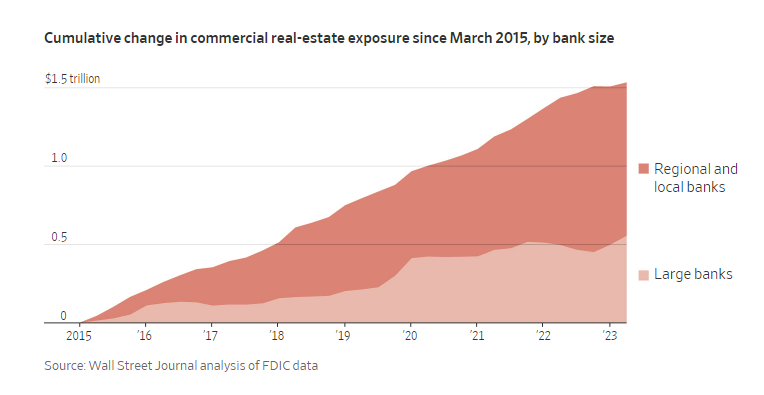by Mish Shedlock, Mish Talk:
 Forget about bank doom loop stories over residential mortgages. Instead put the spotlight where it belongs.
Forget about bank doom loop stories over residential mortgages. Instead put the spotlight where it belongs.
Not Residential!
A reader asked me to comment on Peter Schiff: Banks Have a Bigger Real Estate Problem Today Than They Did in 2007.
Banks are more vulnerable to the housing market now than they were in 2007.
TRUTH LIVES on at https://sgtreport.tv/
Most people in the mainstream will scoff at that statement. They’ll tell you that the situation is very different today. After all, we don’t have a big problem in the subprime mortgage market. We’re not seeing a big spike in defaults. That’s true. The problem is different this time. And it’s actually worse.
So, what’s the problem?
As Peter Schiff explained in a recent podcast, the problem this time is the mortgages themselves.
As Peter points out, a 3% mortgage is a huge asset for the borrower. But it’s a huge liability for the lender. So, defaults would benefit the banks. They could theoretically repossess the home and resell it to somebody else and write a mortgage at a much higher rate.
So, this is a very different crisis. But it’s worse because they’re losing money on every single mortgage they have whether or not they go into default. … So, this is bigger. It is a bigger problem for the banks. They’re losing more money, and they will lose more money now than they did in 2008. That means we’ll need an even bigger bailout. All these ‘too big to fail’ banks have an even bigger problem now than they did then, and it’s going to take an even bigger round of QE to bail them out. The problem is how’s the Fed going to do that when inflation is as high as it is and going higher?
Total Silliness
For starters, banks tend to securitize mortgages they originate or dump them on Fannie Mae.
Second, few will be walking away. There is too much equity for a default crisis as happened in 2007.
Third, the Fed has a liquidity program (BTFP explained below) to help banks paper over losses.
Runs on banks have stopped. If bank runs start again, it will not be due to residential mortgages.
Fed’s Emergency Liquidity Program

The Fed started the BTFP program in the wake of the collapse of Silicon Valley Bank.
Small regional banks overleveraged in long term treasuries and were clobbered by paper losses and then bank runs.
In response, the Fed agreed to shield the banks from losses by offering swaps at par value, ignoring the losses.
BTFP Terms
- Eligible Collateral—Direct obligations of certain U.S. government agencies, including the U.S. Department of the Treasury, government-sponsored enterprises such as Fannie Mae and Freddie Mac, and the Federal Home Loan Banks. In addition, mortgage-backed securities issued and/or fully guaranteed by Ginnie Mae, Fannie Mae and Freddie Mac are eligible.
- Loan Terms—Institutions may borrow up to the value of eligible collateral pledged. Collateral is valued at par, i.e., with no haircuts. Loans can be prepaid at any time without penalty. The rate is fixed for the life of the loan (up to one year) and is calculated by adding 10 basis points to the overnight index swap rate. The rate is published daily on the Discount Window website. Advances will be available until March 11, 2024, or longer if the program is extended.
Liquidity, Not Solvency Issue
This is a liquidity issue, not a solvency issue. The US is not going to default and the treasuries are not worthless. The Fed wanted to stop bank runs and did so by a method that hides losses.
However, the paper losses are still real, even if hidden in reports. This has an impact on banks willingness to make loans in a rising interest rate environment.



